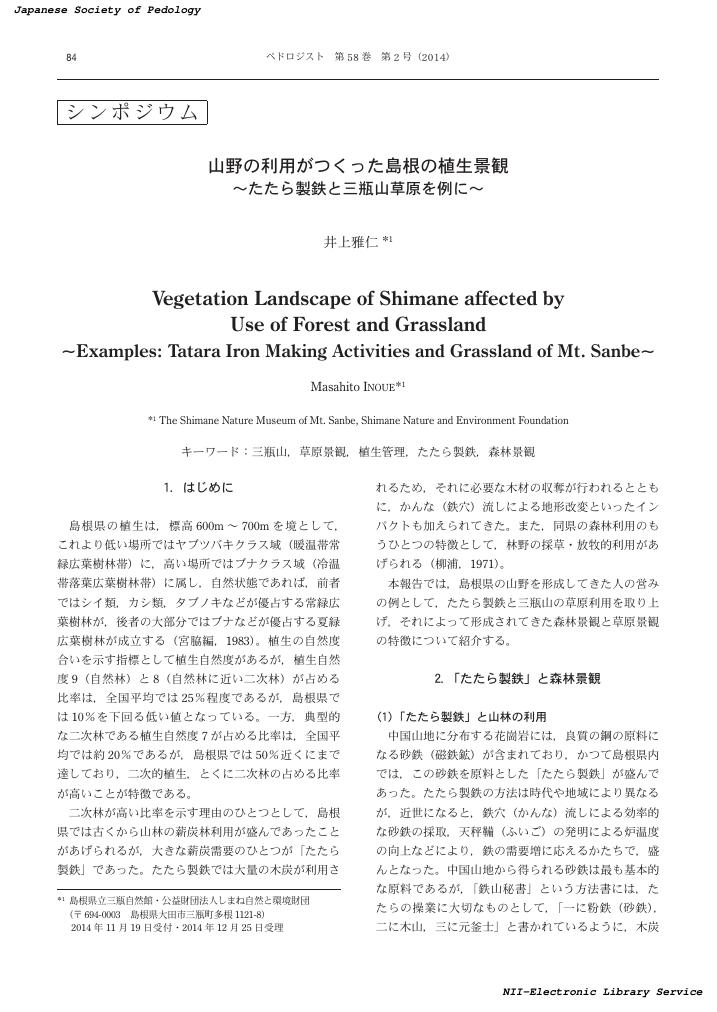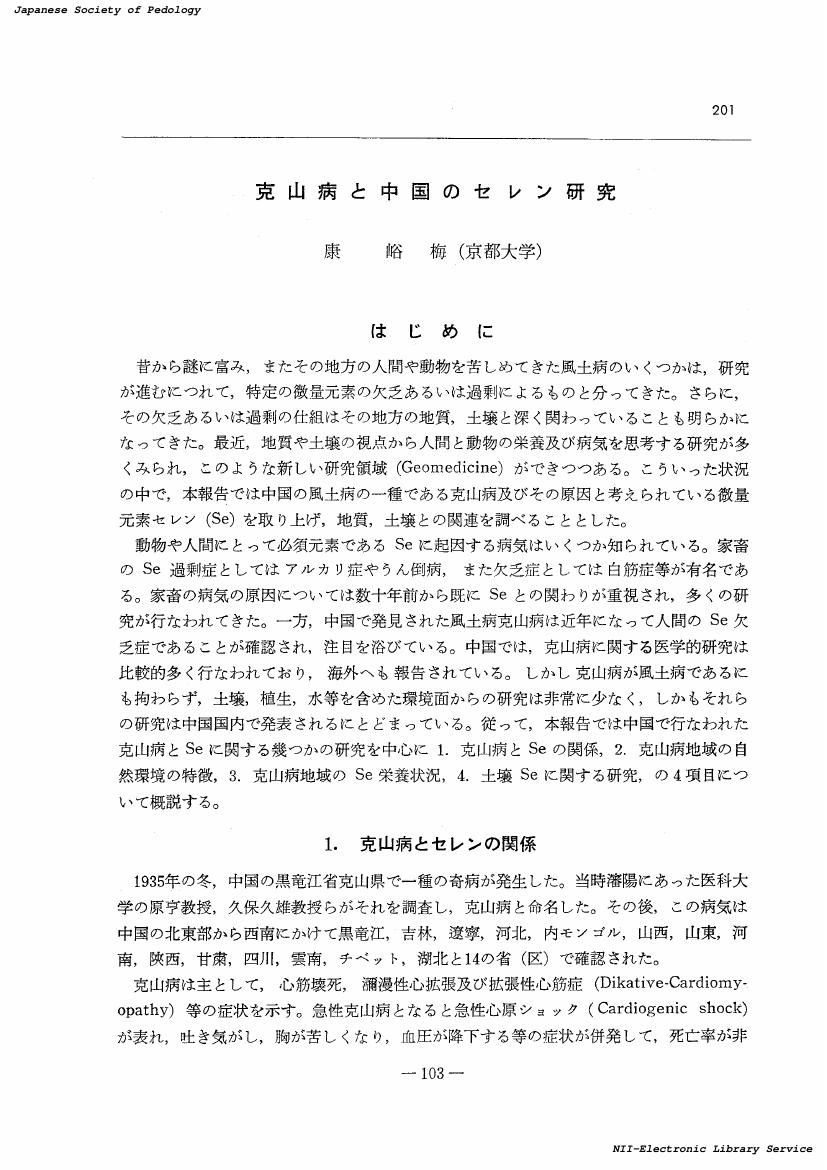1 0 0 0 OA 水田土壌中の灰白色炭酸鉄結核について
- 著者
- 岩佐 安
- 出版者
- 日本ペドロジー学会
- 雑誌
- ペドロジスト (ISSN:00314064)
- 巻号頁・発行日
- vol.3, no.2, pp.53-58, 1959-12-30 (Released:2018-06-30)
A grayish white concretion was taken from the G horizon of a paddy soil developed on the Abe river plain. It was examined by physical and chemical analyses, D. T. A. and X-ray diffraction. From the results obtained, it was concluded that the sample was dominated by siderite (FeCO_3). The sample was crushed and divided into 2 fractions. One fraction was added in water and kept in the constant temperature (28℃), and another kept in room temperature under dry condition. After 35 days, each fraction was again examined by X. R. D. and D. T. A.. It was seen that much more goethite (Fe_2O_3・H_2O) was formed from siderite under the wet condition, but little under the dry condition.
1 0 0 0 OA 黒ボク土の生成におけるススキの意義
- 著者
- 山根 一郎
- 出版者
- 日本ペドロジー学会
- 雑誌
- ペドロジスト (ISSN:00314064)
- 巻号頁・発行日
- vol.17, no.2, pp.84-94, 1973-12-30 (Released:2018-06-30)
Kuroboku soil, is also called ando soil, is characteristic in the accumulation of a great deal of black-colored humus. The author proposed and idea that the main source of humus should be the dead matter of Miscanthus sinensis. The bases for this were dealt with in the present paper from the view-point of the characteristics of Miscanthus sinensis, which are as follows: 1. This plant can grow under the conditions unfavourable for the growth of common plants. 2. Its seeds have a great propagation power. 3. It was very important in haman life and its growth was protected. 4. It has a great productive power. 5. It does not accumulate sedimented humus. 6. The soil has active aluminum which can accumluate humus.
1 0 0 0 OA 山野の利用がつくった島根の植生景観 : たたら製鉄と三瓶山草原を例に
- 著者
- 井上 雅仁
- 出版者
- 日本ペドロジー学会
- 雑誌
- ペドロジスト (ISSN:00314064)
- 巻号頁・発行日
- vol.58, no.2, pp.84-87, 2014-12-31 (Released:2018-06-30)
1 0 0 0 高等学校地理科目における土壌教育内容の更新の必要性
1 0 0 0 OA 克山病と中国のセレン研究
- 著者
- 康 峪梅
- 出版者
- 日本ペドロジー学会
- 雑誌
- ペドロジスト (ISSN:00314064)
- 巻号頁・発行日
- vol.33, no.2, pp.201-212, 1989-12-31 (Released:2018-06-30)
- 被引用文献数
- 2
- 著者
- 岩佐 安
- 出版者
- 日本ペドロジー学会
- 雑誌
- ペドロジスト (ISSN:00314064)
- 巻号頁・発行日
- vol.16, no.1, pp.14-24, 2018-06-30
本土壌はカンボディアに広くみられる砂質沖積土壌と呼ばれる地域内にみられるものである。土壌母材は中生代の砂岩に由来しており,主に石英砂からなっている。本土壌の分布している地域の気候はカンボディアでもっとも高温で雨量の少ない地域に属している。本土壌は黄橙色をしめす砂質な腐植集積のきわめて少ない土壌で断面全体に斑紋およびpisolite concretions ("buck-shot")がみられ,下層にはplinthiteがみられる。pH(水)はB_<2g>, B_3C_g層を除き低い値をしめし,塩基状態も劣悪である。Al_2O_3やFe_2O_3の表層から下層への移動も弱度ではあるがみられる。一次鉱物は,主として石英からなり,有色鉱物はほとんどみられない。粘土鉱物は,カオリン鉱物が主なものであり,それにバーミキュライト,雲母鉱物,バーミキュライト/雲母鉱物,モンモリロナイト,クロライト(?)からなっている。本土壌はpolygenetic soilsであり,地下水ラテライト性土壌とRed-yellow podzolic soilsの諸特徴を兼ねそなえたregosolicな土壌である。なお,本報告をまとめるに当って,論議・検討に応じて下さった農林省農業技術研究所三土正則・渡辺裕両博士に感謝の意を表しておきたい。〔本土壌の現地調査は1969年8月農林省東北農業試験場山下鏡一氏とともに実施したものである。同氏に対しここに感謝の意を表しておきたい〕。
1 0 0 0 OA 本会学会員近堂祐弘先生のご逝去を悼む
- 著者
- 近藤 錬三
- 出版者
- 日本ペドロジー学会
- 雑誌
- ペドロジスト (ISSN:00314064)
- 巻号頁・発行日
- vol.46, no.2, pp.58-59, 2002-12-31 (Released:2018-06-30)
- 著者
- 宇津川 徹 細野 衛 杉原 重夫
- 出版者
- 日本ペドロジー学会
- 雑誌
- ペドロジスト (ISSN:00314064)
- 巻号頁・発行日
- vol.23, no.2, pp.p134-144,図4p, 1979-12
- 被引用文献数
- 1
The morphologies of animal opal, "Opal Sponge Spicules" in the tephras, distributed in Ichihara districts in Chiba prefecture were investigated. The results obtained were summarized as follows ; 1) The tephra deposits at the localities of Figure 1. in Ichihara terrace land were Anegasaki Formation (mainly AW type tephra) (AF), Shimosueyoshi Loam (SL), Musashino Loam (ML) and Tachikawa Loam (TcL). 2) The contents of animal opal were rich in Anegasaki Formation and Shimosueyoshi Loam, as shown in Figure 2. 3) The animal opals found in tephras were morphologically divided into eight types. They are diaxon type, tryaxon type, tetraxon type, polyaxon type, sterrasters type, desma type, lattice type and anthasters type in table 1. 4) The size of diaxon type animal opal was 100-1100 μ in length, 20-100 μ in width, tryaxon type animal opal was 100-400 μ. in length, 30-80 in width, tetraxon type animal opal was 500-800 μ in length, 70-120 μ in width, polyaxon type animal opal was 150-750 μ in length, 40-70 μ in width, sterrasters type animal opal was 100-200 μ in length, 100-220 μ in width, desma type animal opal was 400-800 μ in length, 30-100 μ in width, lattice type animal opal was 400-900 μ in length, 30-100 μ in width, anthasters type animal opal was 100-500 μ in length, 10-30 μ in width. 5) Except for sterrasters type, there were wide and narrow openings in tubes, some were stuffed with foreign materials. Fragments of spicule type had tubular form the diameter of which was 2-30μ. 6) Optical character of animal opal was distinguishable under microscope, colorless or pale pink color, dark in cross nicols (indirect procedures). The refractive indices of diaxon type animal opal was ; n=1.452-1.453, the refractive indices of sterrasters type animal opal was ; n = 1.440-1.446. Spicules of Recent opal sponge (Sponge spicules of a opal sponge of Sagami Bay) was colorless and transparent. The refractive indices of diaxon type spicules of Recent opal sponge was ; n = 1.441±, the refractive indices of sterrasters type of Recent opal sponge was ; n = 1.440±. From these facts the animal opals were non-crystalline (amorphous).
1 0 0 0 OA 植物ケイ酸体研究II
- 著者
- 近藤 錬三
- 出版者
- 日本ペドロジー学会
- 雑誌
- ペドロジスト (ISSN:00314064)
- 巻号頁・発行日
- vol.49, no.1, pp.38-51, 2005-06-30
- 被引用文献数
- 2
- 著者
- 大倉 利明
- 出版者
- 日本ペドロジー学会
- 雑誌
- ペドロジスト (ISSN:00314064)
- 巻号頁・発行日
- vol.52, no.2, pp.126-128, 2008
- 参考文献数
- 2
1 0 0 0 OA 第21回ペドロジスト・トレーニングコースに参加して(プロファイル)
- 著者
- 坂本 拓矢
- 出版者
- 日本ペドロジー学会
- 雑誌
- ペドロジスト (ISSN:00314064)
- 巻号頁・発行日
- vol.57, no.1, pp.54-56, 2013-06-30
- 著者
- Tamura Kenji Nagatsuka Shizuo Oba Yutaka
- 出版者
- 日本ペドロジー学会
- 雑誌
- ペドロジスト (ISSN:00314064)
- 巻号頁・発行日
- vol.35, no.2, pp.104-116, 1991-12-31
We surveyed the profiles of Andosols (volcanic ash soils), measured hydraulic conductivity and amounts of water-stable aggregates of soil, and observed soil micromorphology with a microscope in experimental successional stands which were established at Sugadaira Montane Research Center, University of Tsukuba, Central Japan. In 6-to 10-year-old successional stands, dominated by Artemisia princeps, we observed development of crumb structure and increase in the amounts of soil aggregates over 2mm, in mean weight diameter, and in hydraulic conductivity. Succession resulted in a change in soil microstructure from subangular blocky to crumb structure. These results suggest that the structure of volcanic ash soils develops in a few years during secondary succession.
1 0 0 0 OA 蔵王火山灰の分布と特性
- 著者
- 三枝 正彦 庄子 貞雄
- 出版者
- 日本ペドロジー学会
- 雑誌
- ペドロジスト (ISSN:00314064)
- 巻号頁・発行日
- vol.28, no.1, pp.14-25, 1984-06-30
- 被引用文献数
- 1
宮城県南部に分布する蔵王火山灰の分布,堆積状態,年代,一次鉱物組成および強磁性鉱物の化学組成を検討し次の結果を得た。1)蔵王火山灰は年代の新しい順に蔵王a,蔵王b.永野および平沢火山灰に分けられた。蔵王a, b,および永野火山灰の降灰の主軸は火口湖"お釜"の真東にあり,噴出源は"お釜"あるいは"お釜"を中心とする中央蔵王と推定された。2)蔵王a, b火山灰の主体は黒色の未風化粗粒火山灰であり,この他にスコリア,白色火山灰を伴っていた。永野火山灰は風化層と黒色火山灰の固結層(青磐)の互層よりなっていた。これらの中でぱ永野火山灰最下部に位置し,赤色スコリアを伴う第4青磐が最も広く分布し,鍵層として重要であった。3)蔵王a, b火山灰の降下年代は古文書の記録や^<14>C年代からそれぞれ約360年前および1,000年前と推定された。また永野火山灰の鍵層である第2, 4青磐層の降下年代は^<14>C年代や遺物からそれぞれ5,000〜7,000年前および26,000〜32,000年前と推定された。4)蔵王火山灰の重鉱物組成は新旧をとわず,シソ輝石が大半で,この他に普通輝石,火山ガラスおよび強磁性鉱物とごく少量のかんらん石からなっていた。また軽鉱物としては有色ガラスが主体でこの他に斜長石が存在した。一方蔵王火山以外を噴出源とする愛島火山灰の重鉱物組成は普通角閃石,強磁性鉱物を主体とし,軽鉱物としては自型の石英が多量に存在した。5)蔵王火山灰の強磁性鉱物の化学組成はVが多く,Znが少ない。これに対して愛島火山灰ではZnが多く,Vが少なかった。火山灰の岩質を強磁性鉱物のV-Znベルトから判定すると,蔵王火山灰は玄武岩質安山岩,愛島火山灰は流紋岩質であった。
- 著者
- 木内 知美
- 出版者
- 日本ペドロジー学会
- 雑誌
- ペドロジスト (ISSN:00314064)
- 巻号頁・発行日
- vol.30, no.1, pp.68-75, 1986
1 0 0 0 OA 土壌被の発達と透水性 : 細粒質ポドゾール性土の形態および理化学性の変化と透水性
- 著者
- 佐久間 敏雄
- 出版者
- 日本ペドロジー学会
- 雑誌
- ペドロジスト (ISSN:00314064)
- 巻号頁・発行日
- vol.15, no.2, pp.70-86, 1971-12-30
The residual weathering crust derived from a fine textured sedimentary rock of Koetoi formation, which is one of the main parent material of podzolic soils and acid brown forest soil in the hilly area of northern Hokkaido, shows very high hydraulic conductivity (K=5×10^<-3>〜2×10^<-2>cm/sec). Vertical distribution patterns of hydraulic conductivity (=K-curve) of acid brown forest soil and related subtypes derived from this parent material have shown somewhat straight feature and hydraulic conductivity of the B-C horizon is in the range from 10^<-4> to 10^<-3>cm/sec. Genesis, morphological, physical and chemical properties of podzolic soils are closely related with their hydrological regime which is mainly controlled with the micro relief and hydraulic conpuctivity of the illuvial horizons, changes in the properties of podzolic soils with increasing humidity are illustrated by the following series of horizon sequences. Humus podzolic (Normal): A_1-A_2-B_<ti>-C Humus podzolic surface gleyed: A_1-A_<2g>-B_<ti>-C Podzolic pseudogley: A_1-A_<2(g)>-B_<tg> C_g or CG The K-curves of humus podzolic soils formed under the leaching-out water regime have the minimum value of about 10^<-5>cm/sec at the well developed illuvial horizon. During the humid season, upper soddy or illuvial horizons of humus podzolic surface gleyed subtypes are almost saturated with the stagnant water, which stagnate on the lower impermeable illuvial horizons (K=10^<-6>〜10^<-5>cm/sec). However, B-C or C horizons of this subtype of podzolic soils have moderately high hydraulic conductivity in the range from 5×10^<-4> to 5×10^<-3>cm/sec. The k-curves of podzolic pseudogley show the rapid decrease of hyaraulic conductivity down to the profile and conductivity of the Cg horizon of them is so slow (K≦10^<-5>cm/sec), that the B_<tg> horizon is left in the periodical stagnant water regime. According to the component analysis, variations of properties of these soils are closely linked to (1) the humus accumulation and related changes of physical and chemical properties, (2) formation of impermeable illuvial horizons and (3) changes of the soil water regime induced by the formation of impermeable layer in the profiles. From the results described above, it may be concluded that changes of physical properties, such as the reduction of coarse pore fraction and increase of bulk density, in the B horizons followed with the reduction of permeability lead the succession of heavy podzolic soils by controlling the water regime of them.
- 著者
- 原田 竹治
- 出版者
- 日本ペドロジー学会
- 雑誌
- ペドロジスト (ISSN:00314064)
- 巻号頁・発行日
- vol.12, no.1, pp.38-42, 1968-06-30
1 0 0 0 OA 十和田火山灰層におけるハロイサイトの産状について
- 著者
- 三枝 正彦 庄子 貞雄
- 出版者
- 日本ペドロジー学会
- 雑誌
- ペドロジスト (ISSN:00314064)
- 巻号頁・発行日
- vol.36, no.1, pp.2-16, 1992-06-30
The occurrence of halloysite in Towada Holocene and Pleistocene Tephras was investigated. Formation of halloysite took place in the buried tephras occurring in "Si accumulating zone" where thickness of overburden tephra. deposits were mostly 2 m or greater, and the following forms of halloysite were observed ; spheroidal, elongated spheroidal, twin of spheroidal, chestnut-sheell-like and tubular. Tubular halloysite was dominated in buried A horizon or crack zone of outcrop, whereas spheroidal halloysite was dominated in B, C horizons or noncrack zone of outcrop. The absence of chestnut-shell-like halloysite in Holocene tephras indicate that spheroidal and tubular forms of halloysite were formed concurrently in these tephras. On the other hand, in Pleistocene tephras, the following transformation of halloysite was also suggested ; spheroidal → chestnut-shell-like → tubular. The mean size of spheroidal halloysite in B or C horizon or noncrack zone of outcrop and that of tubular halloysite in all tephras increased with age of tephra. Beside, the mean diameter of spheroidal halloysite in buried A horizon or crack zone of outcrop increased till Takadate tephra, but decreased in Tengutai tephra indicating the depletion of Al supply in this oldest tephra. Results obtained in this study thus indicate that surface weathering of tephra influenced the form and amounts of halloysite formed by geochemical weathering.









